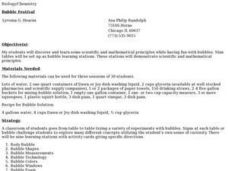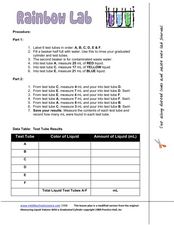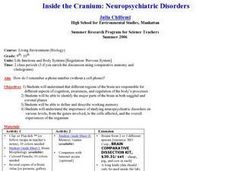Curated OER
Soil Types
Fifth graders examine how sand and rock fragments in soil are products of erosion or the weathering of rocks. They listen to the book "Sand" by Ellen J. Prager and answer discussion questions. Next, they analyze sand samples and sort...
Curated OER
Thunderstorm Outflow I
Students study the characteristics of thunderstorms. They view an animation of radar reflectivity that depicts a thunderstorm and its outflow to locate the thunderstorm's outflow. Afterward, they explain what physical process occurs in a...
Curated OER
The Earth's Ecosystems
For this ecosystem worksheet, learners complete 6 short answer questions and complete 10 word puzzles about marine and land ecosystems.
Curated OER
Fun Activities Using Seeds
Students analyze the size, shape, and form of several different seeds. In this all about seeds lesson plan, students complete four activities involving characteristics of seeds. Students observe the seeds, record information about the...
Curated OER
Bubble Festival
Students practice scientific inquiry while learning about bubbles. In this lesson about bubbles, students explore characteristics of bubbles. Students move through nine different "bubble" stations following directions and completing an...
Curated OER
Rainbow Lab
For this mixtures worksheet, students experiment with different amounts of solutes and solvents to make solutions. They observe color changes and look for chemical and physical changes in the test tubes. Students answer 5 questions and...
Curated OER
I Want It! I Need It!
Students compare the difference between needs and wants. In this needs vs. wants lesson, students play a sorting game with picture cards, depicting illustrations of survival needs and material things. Students sort the picture cards into...
Curated OER
Stream Study
Students study the characteristics of a stream habitat. For this life science lesson, students use sieves, nets, and jars to collect aquatic organisms. Students also measure the temperature of the stream and calculate the speed of the...
Curated OER
The Geography of Russia
In this geography of Russia worksheet, students read a 4 page article about the geography of Russia and complete short answer questions and assignments based on the article. Students complete 6 assignments.
Curated OER
Hurricane Predictions
In this hurricane activity, students analyze and interpret a hurricane graph. They complete 5 short answer questions that follow.
Curated OER
Sensational Slime
Students mix solutions of polyvinyl alcohol and borax. They predict what happen and record their observations. They prepare a T-chart comparing Jell-o to their mixture.
Curated OER
Earth's Winds, Crust, and Atmosphere
This site provides a variety of activities and worksheets about the problem-based learning activity about Earth and its atmosphere. The lessons can be used separately or together in a geology unit. The resources and charts are very...
Curated OER
Ping!
Seventh graders study side-scan sonar and discover how it can be used to locate objects underwater. They complete a sonar simulation activity in which they create and map mystery landscapes inside shoeboxes.
Curated OER
Frogs Losing Ground
Students explore an exhibit through an interactive program on frogs. They can listen to the different sounds frogs make and the different types of frogs. They search for the types of frogs they find in their local area.
Curated OER
Plum Stone Dice Game
Students read about a Native American dice game online. They make replica games, and practice playing with them. They predict the outcome of the dice rolls by completing a dice throw chart.
Curated OER
1928 Flu
Students state the some diseases are the result of infection. They describe the risks associated with biological hazards, such as viruses. Pupils name ways that infectious disease can be prevented, controlled, or cured. Students...
Curated OER
Inside the Cranium: Neuropsychiatric Disorders
Young scholars analyze different regions of the brain which are responsible for different aspects of cognition, awareness and regulating the body's process.
Curated OER
Habitats and Adaptations
Young scholars research and describe the habitat and adaptations of a reef animal. After the student is assigned a habitat, they design and draw a cresture adapted to eat each food and to live in each habitat.
Curated OER
Rainbow Electrophoresis Lab
Students are introduced to the principles of gel electrophoresis. They practice loading gels and pipetting. In this laboratory activity, food color is separated into constituent pigments. The lab can be run with standard electrophoresis...
Curated OER
Tear the Continents
Students tear paper into representative continent shapes and configure them with world oceans through relative location, direction and latitude and longitude starting points. They recognize the shape of the continents. Students recognize...
Curated OER
The Ottoman Empire
Students recognize that the Ottoman Empire was at its grandest during the reign of Suleyman the Magnificent. They use a map to draw in the extent of and the details of the Ottoman Empire during hie reign. In addition, they prove the...
Curated OER
Plant Pigments
Students investigate the components of chlorophyll. They use paper chromatography to separate the many pigments of chlorophyll from one another.
Curated OER
Igneous Rock Features
In this igneous rock worksheet, students will use clay to make a model of igneous rock structures. Then students will complete 5 short answer questions.
Curated OER
Worksheet 3: Vocabulary Review
As a short review of vocabulary, this 10 question activity is a good way to have learners practice words rich in meaning. This worksheet would be appropriate for upper elementary and any older ESL student.

























